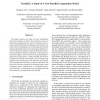Free Online Productivity Tools
i2Speak
i2Symbol
i2OCR
iTex2Img
iWeb2Print
iWeb2Shot
i2Type
iPdf2Split
iPdf2Merge
i2Bopomofo
i2Arabic
i2Style
i2Image
i2PDF
iLatex2Rtf
Sci2ools
IPPS
2007
IEEE
2007
IEEE
ParalleX: A Study of A New Parallel Computation Model
This paper proposes the study of a new computation model that attempts to address the underlying sources of performance degradation (e.g. latency, overhead, and starvation) and the difficulties of programmer productivity (e.g. explicit locality management and scheduling, performance tuning, fragmented memory, and synchronous global barriers) to dramatically enhance the broad effectiveness of parallel processing for high end computing. In this paper, we present the progress of our research on a parallel programming and execution model - mainly, ParalleX. We describe the functional elements of ParalleX, one such model being explored as part of this project. We also report our progress on the development and study of a subset of ParalleX - the LITL-X at University of Delaware. We then present a novel architecture model - Gilgamesh II - as a ParalleX processing architecture. A design point study of Gilgamesh II and the architecture concept strategy are presented.
Distributed And Parallel Computing | Gilgamesh II | IPPS 2007 | Model | Synchronous Global Barriers |
Related Content
| Added | 03 Jun 2010 |
| Updated | 03 Jun 2010 |
| Type | Conference |
| Year | 2007 |
| Where | IPPS |
| Authors | Guang R. Gao, Thomas L. Sterling, Rick Stevens, Mark Hereld, Weirong Zhu |
Comments (0)

